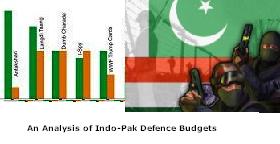|

An Analysis of Indo-Pak Defence Budgets
By
Dr. Raja Muhammad Khan
Over the last decade, there has been increase in the military spending of almost all countries of the world. According to Stockholm International Peace Research Institute (SIPRI), estimates, released on June 2, 2010, 1531 billion USD were expended on militaries as the defence budgets. Overall, there has been an increase of 5.9 percent in the defence spending during 2009, as compared to year 2008. However, there been huge increase in the military budgets since 2000. The estimated increase is 49 percent from year 2000 to 2009.
For the next financial year, 2010-2011, Pakistan has increased its defence budget by 16.935 percent. In real term, this increase is less than 5 percent, once the over 12 percent infatuation rate is incorporated into it. As per the Finance Minister, the major cause of this marginal increase in the defence budget is that, “We are facing a situation in which our armed forces, paramilitary forces, and security forces are laying down their lives ... They should know from this House that we all stand by them and that Security is our topmost concern”. In the wake of the ongoing counter insurgency operations, in FATA, KP and parts of Balochistan Province, this increase is considered minimum essential. Otherwise, bulk of the budget is expended on the pay and allowances and maintenance expenditures of defence personnel and the current holdings.
As compared to 5.2 billion USD Pakistani defence budget 2010-2011, Indian defence budget for the same duration announced in February 2010, is 32 billion USD. Once compared, Indian defence budget is approximately five times more than Pakistani defence budget. Indeed, the Revenue expenditure of Indian Defence has grown from Rs. 10,194 cores in 1989-90 to Rs. 87,344 corer in 2010-11, i.e. an increase of almost nine times during the last two decades.
There has been a constant decrease in the defence spending of Pakistan in terms of GDP since 2000. It is now around 2 percent of the GDP as compared to over 4 percent in 1980s and over 3 percent in 1990s. Although, even this budget is unaffordable for the economically poor countries like Pakistan, but, in view of a constant Indian threat on the eastern borders and a state of war since last nine years along the western borders has necessitated this defence spending. Premier Yousaf Raza Gillani has recently said that, “We remain concerned over Pakistan-specific Indian military doctrines such as the cold start envisaging a limited conventional war under the nuclear overhang, huge increase in the Indian military budget and massive weapon acquisition.”
As per the Military Balance 2010, issued by the Renowned British Think Tank; IISS, growth in India fell to 7.3 percent in 2008, after have excellent average growth rate of 8.75% annually in previous five years. It has fallen to less than 6 percent in 2009. Nevertheless, despite the tight fiscal background, Indian has not reduced its defence spending. Rather, from 2000 to 2009 the defence budget has been enhanced to 50% in real terms. After the Mumbai attack, November 2008, the defence was increased to another 21%. Furthermore, the immediate impact of the late November attacks can be seen in revised budget figures for 2008, which included a 32% increase in spending by the army over its original allocation. This Indian heavy defence spending has been pointed out by both the Asian Development Bank and the IMF. They have warned that India’s large and persistent budget imbalance threatens fiscal sustainability, and they have urged the authorities to consider a new, stronger budgetary framework when the existing Fiscal Responsibility and Budget Management Act (FRBMA) expire in 2010. However, in 2010 budget, there is another increase of 34 percent in the Indian defence Budget in real terms.
This heavy Indian Defence expenditure, five times more than Pakistan is primarily being expended on the modernization of its three services. The particular attention is being given to Indian Air Force and Navy. Through the enhancement in its naval and air power, India intends achieving the superiority over Pakistan, which Indian Army could not get in spite of its being two times more than Pak Army is. India is adding latest submarines having the nuclear capability in its naval fleet. These include the sophisticated Akula class and French origin submarines. India air force equally being modernized through the purchase of MiG 35 and F-16/18 aircraft. Its Army is following the Cold Start Doctrine against Pakistan and has more recently threatened to fight a limited war under nuclear overhang. It has even hinted to fight two fronts war against China and Pakistan simultaneously.
Under these real time threats and involvement of Pakistani Security Forces all along the Western Borders, and other internal fronts, Pakistan cannot remain aloof to its defence needs. It has to match or at least present minimum credible deterrence to its adversaries. For the maintenance cost and the up dating of its arsenals, it need minimum defence budget. The Government of Pakistan has realized the essentiality of these requirements, thus made the defence allocation to keep its forces worthy to fight the tough challenges ahead.
The writer is a South Asian analyst. Email: drmk_edu@yahoomail.com
|